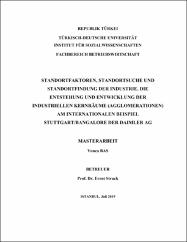| dc.contributor.advisor | Struck, Ernst | |
| dc.contributor.author | Bas, Yonca | |
| dc.date.accessioned | 2020-03-06T23:43:19Z | |
| dc.date.available | 2020-03-06T23:43:19Z | |
| dc.date.issued | 2019 | |
| dc.identifier.citation | Bas, Yonca. (2019).Standortfaktoren, standortsuche und standortfindung der industrie. Die entstehung und entwicklung der industriellen kernräume (agglomerationen) am internationalen beispiel Stuttgart/Bangalore der Daimler AG. Türk-Alman Üniversitesi, Sosyal Bilimler Enstitüsü, İstanbul. | en_US |
| dc.identifier.uri | https://hdl.handle.net/20.500.12846/63 | |
| dc.description.abstract | The Master's thesis will deal with the question of which factors contributed to Daimler AG choosing Stuttgart and Bangalore as its locations. In this context, the question arises as to whether every company can settle anywhere with efficient effects. To answer this question, it is crucial to weigh up the location factors. Since not every company comes from the same industry, the needs are designed individually in relation to the location factors. A distinction is made between measurable and subjectively perceived location factors. In addition, utility value analyses are carried out, so that the company can make an initial efficient investment decision with its choice of location. As has already been pointed out, utility analyses are nothing more than an extended form of Alfred Weber's theory. Alfred Weber was the first in 1909 to try to find an optimal location for a company. According to Weber, a location is only favorable if it permits cost-effective production. The main location factors he examined were transport costs, labor costs and agglomeration advantages. Although this theory cannot be realistically implemented today, it is still used and expanded as a guideline. In return, the choice of location is compared using the "modern models" of e.g. Krugman and Romer. These models examine the creation of sustainable global growth. Finally, the factors within two different countries (Daimler AG) are also investigated using certain methods and models. The choice of a location requires a high use of resources through investments in assets and is therefore not only a complex long process, but also a long-term decision that cannot be reversed without significant costs. In addition, companies with the right choice of location intend to increase and secure their international competitiveness and competitive advantages. When it comes to setting up business in Bangalore, it can essentially be said that the hard location factors of "politics" and "culture" play a special role. How international competitiveness has developed in Stuttgart and Bangalore and which other factors are relevant will be presented in the course of the Master's thesis. | en_US |
| dc.description.abstract | Bu tez kapsamında, Alman otomobil endüstrisinde ileri gelen şirketlerden birisi olan Daimler AG'nin neden stratejik konum olarak Bangalore ve Stuttgart’ı seçtiği çalışmanın konusu olarak ele alınmıştır. Böylelikle, oluşan “Herhangi bir şirket herhangi bir konuma verimli bir şekilde yerleşebilir mi?“ sorusuna yanıt aranmıştır. Bu bağlamda, dikkat edilmesi gereken noktalardan biri olarak konum faktörleri, büyük önem arz etmektedir. Birçok şirket farklı alanlarda faaliyet gösterdiklerinden dolayı kendilerine özgü konum faktörleri vardır. Bu faktörler ölçülebilir ve öznel olarak ikiye ayrılmaktadır. Buna ek olarak, şirketler nezdinde yeni bir konuma yatırım yapılmasından önce, maliyet analizi yapmaları gerekmektedir. Maliyet analizi, ilk kez 1909 yılında Alfred Weber tarafından bir şirketin en uygun şekilde konumlandırılabilmesi için ele alınmıştır. Weber’e göre en iyi konum; taşımanın, iş gücünün ve yığılma ekonomilerinin en uygun olduğu yer olarak tanımlanmaktadır. Weber’in teorisi günümüz şartlarına göre uygun olmamasının yanı sıra birçok noktada tekrar uyarlanıp kullanılabilmektedir. Ayrıca, Krugman ve Romer’in teorisi olan "modern modeller", konum bulma konusunda kıyaslanmakta olup, bu modeller sürdürülebilir küresel büyümenin oluşumu açısından inceleme imkanı sağlamaktadır. Sonuç olarak, bu faktörler çeşitli metotlar ve modeller aracılığı ile Daimler AG’nin iki ülkede bulunan konumları örneği üzerinden araştırılmaktadır. Yeni bir yer seçimi, varlıklara yatırım yapılarak yüksek miktarda öz kaynak kullanılmasını gerektirmektedir. Bu husustan dolayı, seçim süreci karmaşık olmasının yanı sıra geri dönünüşü olamayan bir karar aşaması olarak görülmektedir. Verilen kararlar ile şirketler hem uluslararası rekabet güçlerini hem de rekabet avantajlarını arttırmayı amaçlamaktadır. Bilhassa Hindistan’da yerleşim için “siyaset“ ve “kültür“ çok büyük bir etken olarak görülmektedir. Tezin ilerleyen bölümlerinde ise Hindistan ve Stuttgart’taki uluslararası rekabet gücünün nasıl geliştiği ve hangi faktörlerin önem taşıdığı ele alınacaktır. | en_US |
| dc.language.iso | deu | en_US |
| dc.publisher | Türk-Alman Üniversitesi | en_US |
| dc.rights | info:eu-repo/semantics/openAccess | en_US |
| dc.subject | Konum faktörleri | en_US |
| dc.subject | Şirketler | en_US |
| dc.subject | Location factors | en_US |
| dc.subject | Companies | en_US |
| dc.subject | Standortfaktoren | en_US |
| dc.subject | Unternehmen | en_US |
| dc.title | Standortfaktoren, standortsuche und standortfindung der industrie. Die entstehung und entwicklung der industriellen kernräume (agglomerationen) am internationalen beispiel Stuttgart/Bangalore der Daimler AG | en_US |
| dc.type | masterThesis | en_US |
| dc.relation.publicationcategory | Tez | |
| dc.contributor.department | TAÜ, Sosyal Bilimler Enstitüsü, İşletme Yönetimi Ana Bilim Dalı | en_US |
| dc.contributor.institutionauthor | Bas, Yonca | en_US |

















